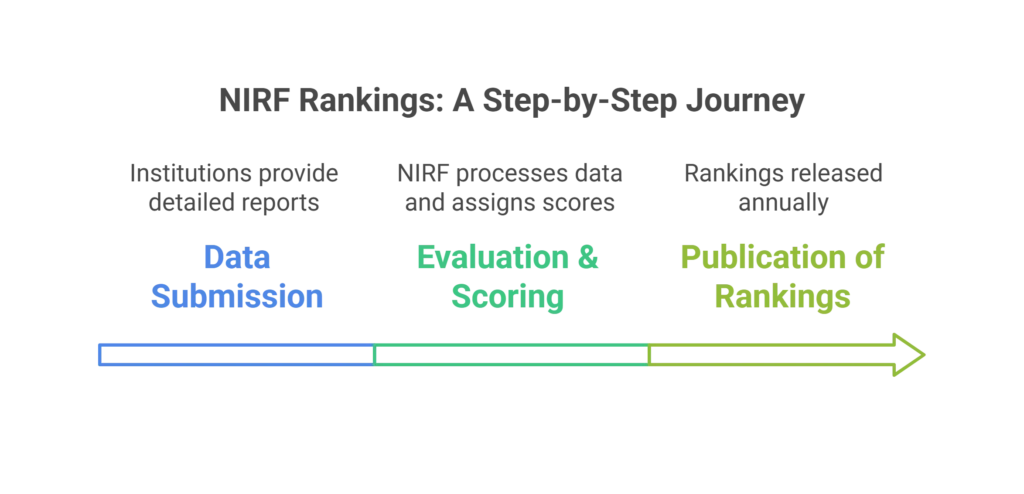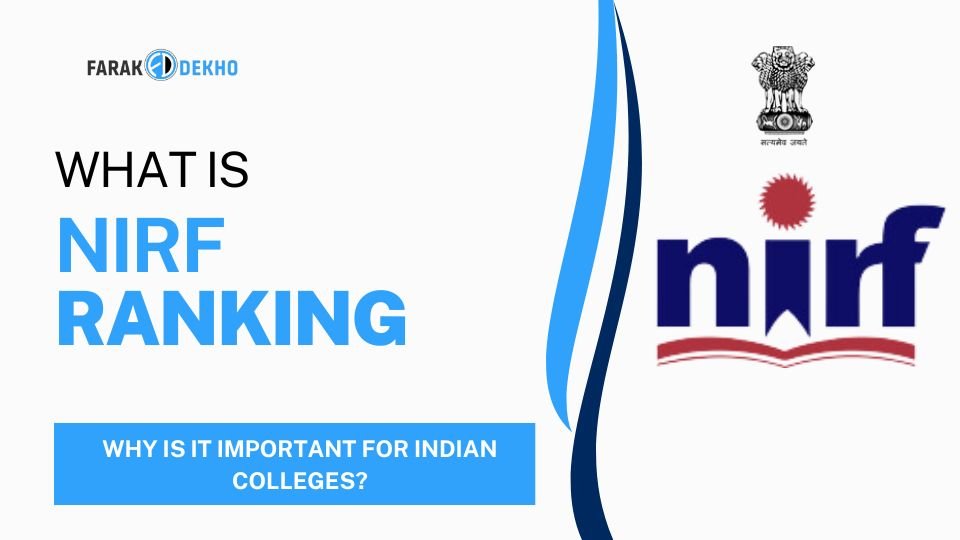The National Institutional Ranking Framework (NIRF) is a methodical technique of ranking the educational institutions that are considered to be of better quality in India. The Ministry of Education of the Indian Government was responsible for initiating it. According to this paradigm, colleges and universities are evaluated based on a number of different criteria, such as perception, outreach and inclusivity, research and professional practice, teaching and learning, and graduation rates.
Improving an institution’s reputation also entails creating a strong brand identity and cultivating essential stakeholder relationships. These efforts are especially important for an online MBA college in India, helping to attract ambitious professionals and foster a dynamic academic community that thrives on collaboration and innovatio
What Is NIRF Ranking?
The National Institutional Rating Framework (NIRF) was formed in 2015 with the goal of developing a transparent and dependable rating system for educational institutions in India. The rankings allow students, parents, and legislators to evaluate the effectiveness of educational institutions while also encouraging them to improve their standards.
Thousands of colleges and universities voluntarily enrol in the National Institutional Research Framework (NIRF) to demonstrate academic achievement. NIRF is becoming the industry standard for academic institutions. The rankings are also an important factor in the institution’s growth because they influence financial, partnership, and student enrolment metrics.
Importance of NIRF Rankings
NIRF rankings come with a long list of advantages, including but not limited to the following:
- If universities are serious about achieving the highest levels of academic accomplishment, they must prioritise raising the bar for their faculty, curriculum, and student results.
- An institution’s global reputation, as evidenced by its place in the National Institutional Ranking Framework (NIRF) rankings, influences its capacity to attract students and teachers from all over the world and collaborate efficiently.
- As one progresses through the ranks, the prospects of securing commercial sponsorship and government financing improve. Additionally, the chances of receiving funding increase.
- Job Prospects: Highly ranked colleges attract a higher concentration of recruiters, resulting in better placement outcomes for students. This increases the number of available work opportunities for pupils.
- Students and their families can get help making informed judgements about which college or university best matches their needs, taking performance into account.
Key Parameters of NIRF Ranking
NIRF evaluates institutions based on five key parameters, with a total score of 100 points.
A. Teaching, Learning & Resources (TLR) – 30% Weightage
This parameter assesses faculty qualifications, student-faculty ratio, and availability of academic resources.
| Sub-Parameter | Description | Marks |
|---|---|---|
| Faculty-Student Ratio (FSR) | Number of students per faculty member | 20 |
| Faculty Qualifications & Experience (FQE) | Percentage of faculty with PhD and teaching experience | 30 |
| Library & Laboratory Facilities (LL) | Investment in books, journals, and lab equipment | 40 |
| Sports & Extracurricular (SEC) | Availability of sports and cultural activities | 10 |
B. Research & Professional Practice (RP) – 30% Weightage
Assesses research output, patents, and professional collaborations.
| Sub-Parameter | Description | Marks |
| Research Publications | Indexed publications in global databases | 30 |
| Citation Impact | Number of citations per research paper | 30 |
| Patents & Technology Transfer | Number of patents filed, granted, and licensed | 20 |
| Funded Research Projects | Grants and funding received from external agencies | 20 |
C. Graduation Outcome (GO) – 20% Weightage
Measures the success rate of students in completing their degrees and securing employment.
| Sub-Parameter | Description | Marks |
| University Examinations | Percentage of students passing with distinction | 40 |
| Higher Studies & Employability | Number of students pursuing further education or securing jobs | 40 |
| Median Salary | Average salary of graduates | 20 |
D. Outreach & Inclusivity (OI) – 10% Weightage
Evaluates an institution’s commitment to diversity and accessibility.
| Sub-Parameter | Description | Marks |
| Regional & Social Diversity | Students from different states and economic backgrounds | 30 |
| Women’s Representation | Percentage of female students and faculty | 30 |
| Differently Abled Facilities | Infrastructure for students with disabilities | 20 |
| Scholarships & Financial Aid | Availability of financial assistance programs | 20 |
E. Perception (PR) – 10% Weightage
This parameter reflects how an institution is perceived by peers, employers, and the public.
| Sub-Parameter | Description | Marks |
| Academic Reputation | Rating by other institutions | 50 |
| Employer Reputation | Survey-based score from industry professionals | 50 |
Have questions about NIRF rankings?
Fill out the contact form & get expert guidance! 🚀
How does the NIRF collect data and what are its procedures?
The following are the responsibilities of institutions in order to ensure that they conduct an impartial evaluation:
- Data must be submitted via the NIRF website.
- Maintain records that are publicly accessible for the purpose of verification.
- To validate your research, it is recommended that you utilise reputable databases, including Scopus and Web of Science.
- Details regarding compensation and placement should be furnished by recruiters and graduates.
What are the steps to implement NIRF rankings?
The NIRF ranking procedure requires universities to provide statistics on faculty, research, student enrolment, and campus infrastructure. NIRF uses predefined algorithms to process data and assign scores. Schools can use the annual rankings to assess their success and identify areas for improvement.

- Level 1: Data Submission Institutions offer detailed reports on faculty, research, student enrolment, and campus facilities.
- The second step involves scoring and evaluating. – After receiving the data, NIRF employs established formulas to evaluate the submissions.
- Finally, They will publish the rankings. – The annual publication of the rankings allows institutions to review their accomplishments and devise strategies for improvement.
What are the challenges and future scope of NIRF?
The NIRF is facing two obstacles that threaten its future scope: uneven resource allocation and data accuracy issues. Future plans aim for artificial intelligence-powered ranking systems, student feedback measures, and extended coverage to include online education platforms and vocational training centres.
Challenges
- Data Accuracy: Some institutions may submit exaggerated claims.
- Infrastructure Gaps: Uneven distribution of resources across institutions.
- Limited Awareness: Many colleges do not participate in NIRF rankings.
Future Scope
- AI-Based Ranking Mechanisms: Automating data validation for more accuracy.
- Student Feedback Metrics: Incorporating student satisfaction surveys.
- Expanding Scope: Including vocational training institutions and online education platforms.
Strategies for Institutions to Improve NIRF Ranking.
The National Institute of Research and Development (NIRF) is an international agency dedicated to promoting research innovation and quality. To improve their ranking, institutions should focus on improving faculty strength, increasing research output, improving graduation outcomes, promoting diversity, and improving reputation.

To improve NIRF rankings, institutions should focus on:
- Enhancing Reputation: Strengthening employer ties and engaging with academic peers.
- Enhancing Faculty Strength: Hiring more PhD-qualified faculty and improving faculty-student ratios.
- Boosting Research Output: Increasing publication rates in indexed journals and securing patents.
- Improving Graduation Outcomes: Strengthening placement cells and industry collaborations.
- Promoting Diversity: Increasing scholarships and outreach programs for underprivileged students.
Closing remarks
The National Institutional Evaluation Framework (NIRF) evaluation framework is an important tool for evaluating higher education institutions in India. Universities and colleges can improve their rankings and reputation in the international community by focusing on faculty excellence, research production, inclusivity, and public perception.
The National Institutional Review Framework (NIRF) is a benchmark for students, educators, and policymakers in India, allowing them to make informed decisions and raise educational standards.
FAQ
Answer: NIRF stands for National Institutional Ranking Framework. It is a system used by the Indian government to rank colleges and universities based on teaching, research, placements, diversity, and reputation. It helps students choose good colleges and encourages institutions to improve their quality.
Answer: NIRF ranks institutions based on five factors:
Teaching & Learning – How good are the teachers and resources?
Research & Professional Practice – How much research work is done?
Graduation Outcome – How well do students perform after college?
Outreach & Inclusivity – How diverse is the student body?
Perception – What do employers and experts think about the college?
Answer: Yes! Colleges can improve their NIRF ranking by:
Hiring more qualified teachers
Encouraging students and faculty to do research
Improving library, lab, and sports facilities
Helping students get better jobs and placements
Making education accessible to students from different backgrounds
Answer: Students can check the NIRF rankings before choosing a college. A higher-ranked college usually has better faculty, research, and job opportunities. You can find the rankings on the official NIRF website every year.
Answer: No, while NIRF rankings are useful, students should also check other things like course availability, location, fees, campus life, and alumni success. Rankings help, but personal preference matters too!

Lovepreet Sachdeva is an SEO Specialist with extensive experience in helping businesses improve their online presence. He is dedicated to providing top-notch SEO services and personalized strategies to boost your website’s performance. Contact him today for professional SEO assistance.





